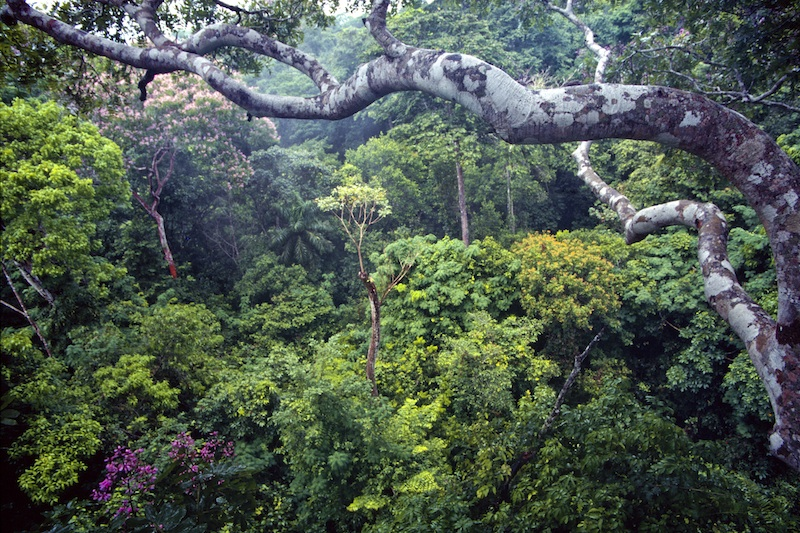Uncovering Networks in Rainforest Plants
The resilience of an ecosystem to environmental and human-induced change may depend on how the system’s plants are arranged. Do they form patchy clumps or networks extending over the whole terrain? A team of researchers in Italy has now shown that, in a tropical rainforest in Panama, the dominant plant species are arranged in so-called scale-free distributions containing clusters with a wide range of sizes [1]. This distribution is characteristic of a system close to a critical state, in which the effects of perturbations can be rapidly felt throughout the system. The observations could help to guide strategies for protecting rainforests and other ecosystems from collapse in the face of environmental change.
Many natural phenomena have been suggested to show behavior or structure reminiscent of a scale-free critical state, from the sizes of avalanches and forest fires to fluctuations in neural signals in the brain and in the activity of genes [2]. In all these systems there is no particular size of events that is favored over others. Such scale-free behavior reflects the fact that correlations between the components of the system make each of them sensitive to what all the others are doing. This sensitivity means that a perturbation in one part of the system can be rapidly felt in other parts, promoting a fast system-wide response that can be catastrophic in the case of an earthquake or avalanche but can be beneficial in a living entity like a brain or an ecosystem.
The idea that some vegetation ecosystems might show scale-free clustering is not new. It was proposed nearly 30 years ago [3] based on data from the rainforest canopy of Barro Colorado Island (BCI) in Panama and was also reported for arid regions of the Kalahari Desert in southern Africa [4]. Other ecosystems, in contrast, show regular patterns [5] or features with a particular length scale [6]. In general, however, it is challenging to determine the clustering behavior in an ecosystem, partly because there is no obvious way to decide if a given plant belongs to the same cluster as those nearby.
Theoretical physicist Pablo Villegas of the Enrico Fermi Research Center in Italy and colleagues have brought the methods of statistical physics to bear on this problem. They applied their analysis to data from the BCI research station, where 300 plant species on a 50-hectare plot have been monitored continuously for 40 years. Using the locations of more than 400,000 trees and shrubs, the researchers mapped out the networks of clusters, where a cluster is formed by connecting all the plants in a region that are separated by less than a given distance r.
For small r, the network consists of small clusters, each with a few closely-packed plants, but for larger r, the cluster size expands until—at some threshold value rc—one single “giant cluster” includes nearly all the plant population. This sudden switch from discrete clusters to a system-spanning cluster is called a percolation transition. It’s seen in many physical systems, from pore networks in rocks to the aggregation of small particles.
When the researchers looked at all the plants together, they found that the percolation transition occurred for rc of around 5 m. However, when the researchers looked at the distribution of the single most abundant species (the shrub Hybanthus prunifolius), a different pattern emerged. For this shrub, there is no abrupt transition, but rather there is a range of r values that produce a “percolating cluster,” which spans the sample area and includes a large fraction of the population. In other words, the single-species distribution has no “special” length scale but shows system-wide clustering over many different scales: the hallmark of a critical state.
Villegas says this structure might offer a compromise between different biological needs, as it allows the species to spread over the entire area while retaining the resilience that comes from local clusters connected through pollination or other short-distance interactions. This scale-free network “could be a very smart self-organization mechanism to increase the robustness of an ecosystem,” he says. On the flip side, interfering with this natural percolation behavior through deforestation may make rainforests susceptible to catastrophic plant loss [7].
“The analysis is beautifully done with a technique that allows for sensible extraction of as much data as possible,” says complex-systems expert Ricard Solé of the University of Pompeu Fabra in Spain, who was the first to suggest that rainforests might be in a critical state [3]. Villegas says he hopes the research will be useful for monitoring the health of species-rich ecosystems.
–Philip Ball
Philip Ball is a freelance science writer in London. His latest book is How Life Works (Picador, 2024).
References
- P. Villegas et al., “Evidence of scale-free clusters of vegetation in tropical rainforests,” Phys. Rev. E 109, L042402 (2024).
- T. Mora and W. Bialek, “Are biological systems poised at criticality?” J. Stat. Phys. 144, 268 (2011).
- R. V. Solé and S. C. Manrubia, “Are rainforests self-organized in a critical state?” J. Theor. Biol. 173, 31 (1995).
- T. M. Scanlon et al., “Positive feedbacks promote power-law clustering of Kalahari vegetation,” Nature 449, 209 (2007).
- M. Rietkerk and J. van de Koppel, “Regular pattern formation in real ecosystems,” Trends Ecol. Evol. 23, 169 (2008).
- Z. Ge, “The hidden order of Turing patterns in arid and semi‐arid vegetation ecosystems,” Proc. Natl. Acad. Sci. U.S.A. 120 (2023).
- F. Taubert et al., “Global patterns of tropical forest fragmentation,” Nature 554, 519 (2018).







